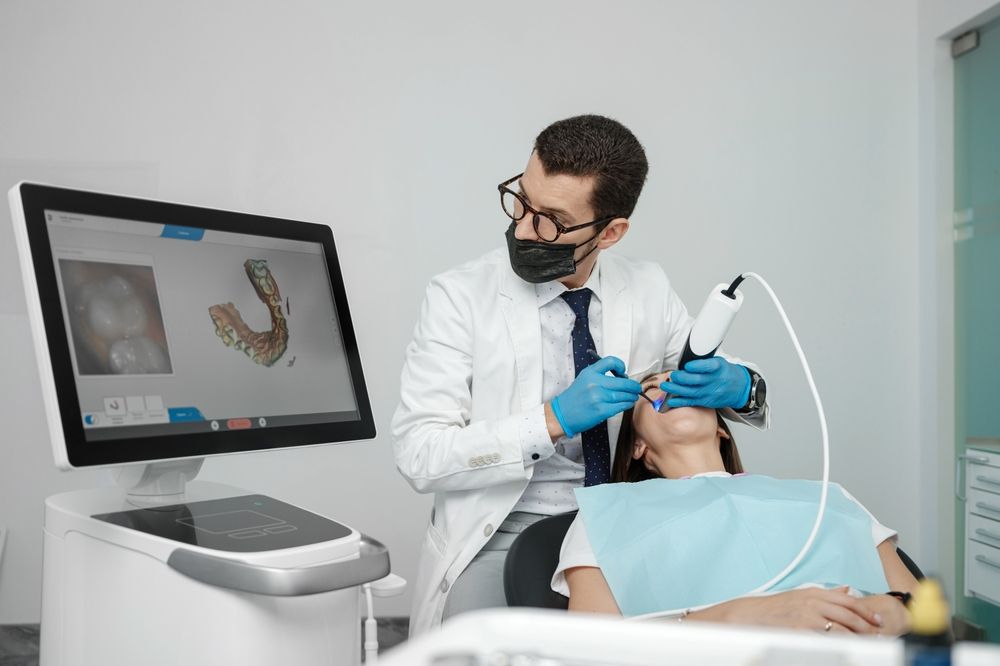At Tulsa Precision Dental in Tulsa, OK, advances in dental technology are reshaping how oral health is diagnosed and treated. One such innovation making a significant impact is the use of intraoral cameras. These small, handheld devices are revolutionizing dental care by providing detailed visuals of the inside of the mouth, enhancing accuracy and improving communication between patients and dental professionals. Dr. Chris Vinson understands the value of technology in creating more effective treatment plans and fostering patient trust.
Understanding Intraoral Cameras
Intraoral cameras are compact, pen-sized tools equipped with tiny cameras that capture high-resolution images inside a patient’s mouth. Unlike traditional methods where dentists relied solely on visual examination and X-rays, intraoral cameras offer a direct, real-time view of teeth, gums, and other oral structures. The images are displayed on a monitor, allowing both dentist and patient to see detailed visuals during the appointment.
The level of detail captured by these cameras is remarkable. Dentists can identify small cracks, early signs of decay, plaque buildup, and gum disease that may be difficult to detect with the naked eye alone. This enhanced visibility leads to earlier diagnosis and more precise treatment recommendations, ultimately improving patient outcomes.
Moreover, intraoral cameras serve as a valuable educational tool. Patients often struggle to understand their oral health when explanations rely solely on verbal descriptions or X-rays. Seeing actual images of problem areas creates a clearer understanding and encourages patients to participate actively in their care decisions. This transparency fosters trust and helps patients feel more informed and comfortable with recommended treatments.
Benefits for Diagnosis and Treatment Planning
The precision of intraoral cameras makes a notable difference in diagnosis. Early detection of dental issues is critical to preventing more extensive and costly procedures later. With intraoral imaging, dentists can spot minute changes in tooth structure or gum health that might otherwise be overlooked during a routine exam.
This technology also enhances treatment planning by allowing dentists to document and compare images over time. By monitoring the progression or improvement of conditions, dental professionals can tailor treatments more effectively and adjust strategies as needed. For example, a patient undergoing periodontal therapy can benefit from visual progress reports showing gum healing, which motivates adherence to home care routines.
Another important advantage is improved communication within the dental care team. If a case requires referral to a specialist, intraoral images provide a clear, visual history that aids in collaborative diagnosis and treatment. This ensures continuity of care and better overall results for the patient.
How Intraoral Cameras Improve Patient Experience
Patients are often anxious about dental visits, partly because of uncertainty about their oral health and treatment needs. Intraoral cameras help alleviate this anxiety by demystifying the dental exam process. When patients see the images of their teeth and gums, they gain a clearer perspective on their condition. This visual engagement helps reduce fear and builds confidence in the dental team.
Additionally, the immediate feedback from intraoral cameras empowers patients to take ownership of their oral health. Seeing plaque deposits or early decay firsthand motivates better daily oral hygiene practices. It also helps patients make more informed decisions about elective procedures, such as whitening or orthodontics, based on accurate and personalized visuals.
The convenience of intraoral cameras cannot be overlooked either. Unlike X-rays, these cameras do not expose patients to radiation and can be used frequently for ongoing monitoring. This makes them a safe and practical tool for all age groups, from children to seniors.
Practical Applications in Everyday Dental Care
Intraoral cameras are versatile tools used in a wide range of dental treatments. They assist in cavity detection, allowing dentists to identify lesions before they become larger problems. They are invaluable in orthodontics for monitoring tooth movement and appliance fit. For restorative dentistry, these cameras help ensure the precision of crowns, bridges, and fillings.
They also play a key role in periodontal assessments, making it easier to detect and document gum inflammation, recession, and other signs of periodontal disease. By visually tracking these conditions, dentists can customize treatment plans and encourage patients to maintain regular periodontal care.
In addition to diagnostic uses, intraoral cameras facilitate insurance documentation. Clear photographic evidence supports claims and helps patients understand the necessity of procedures recommended by their dentists.
Key advantages at a glance:
- Early detection of oral health issues
- Enhanced patient education and engagement
- Improved accuracy in diagnosis and treatment
- Non-invasive and radiation-free imaging
- Better documentation and treatment monitoring
Conclusion
The integration of intraoral cameras into dental care marks a significant advancement in oral health diagnostics and patient communication. At Tulsa Precision Dental in Tulsa, OK, Dr. Chris Vinson recognizes how this technology contributes to more effective and personalized dental care. By providing detailed visuals, intraoral cameras help detect problems earlier, improve treatment outcomes, and empower patients through better understanding of their oral health. As dental technology continues to evolve, tools like intraoral cameras will remain essential in delivering precision care and fostering lasting dental wellness.
Resources
- American Dental Association. (2023). The Role of Intraoral Cameras in Dentistry. Journal of American Dental Association.
- Geetha, V., & Kandaswamy, D. (2019). Clinical Applications of Intraoral Cameras in Modern Dentistry. International Journal of Dental Research.
- Miller, C. S., & Wozniak, W. (2017). Enhancing Patient Communication Through Intraoral Imaging. Journal of Dental Technology and Patient Care.




